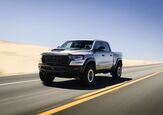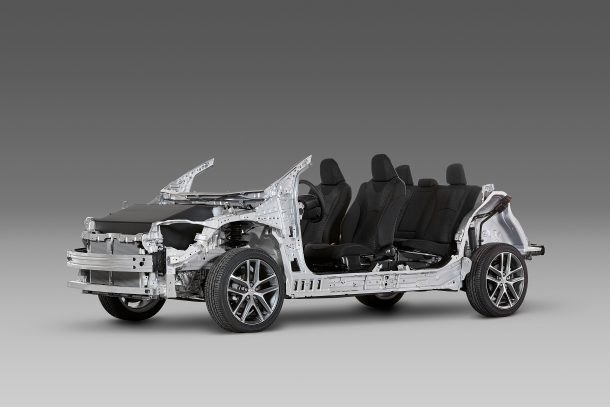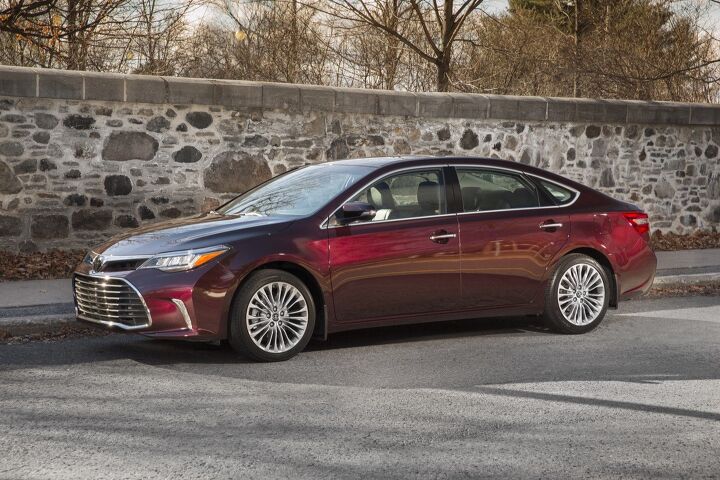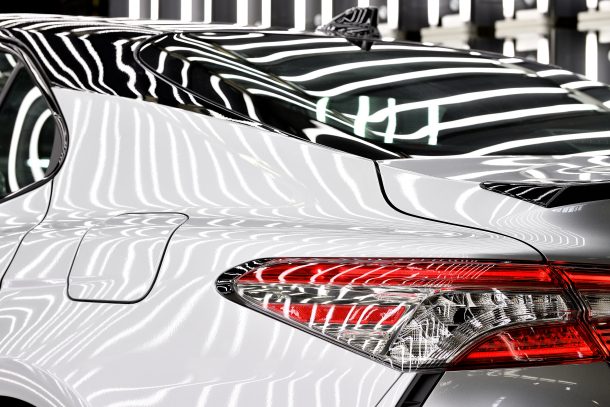#TNGA
Toyota Bringing Yaris-based Crossover to Geneva Auto Show
Toyota has expressed interest in delivering a compact crossover sized smaller than the existing C-HR before, going so far as to offer a few teasers to whet the collective appetite. Another bait image was posted this week, accompanying promises that the automaker will debut the model at the 2020 Geneva Auto Show next month.
While the model could go head-to-head with a handful of rides here in North America, it’s a product aimed primarily at the European market. Based on the TNGA-B platform, the mystery Toyota is supposed to undercut the C-HR in scale and price. Here, that would make it a likely rival for the Nissan Kicks or Ford EcoSport. Both models have seen modest sales growth through their first full year on sale, but there’s not a lot of heat in the segment as a whole.
Toyota will only ship the new crossover as far West as it thinks is profitable.
Why a Joint Toyota-Mazda RWD Platform and Inline-6 Engine Makes Sense
A Mazda inline-six cylinder engine developed for a rear wheel-drive-based platform has been industry knowledge since news broke in May. But new reporting from Best Car in Japan confirm that Toyota/Lexus and Mazda will share that rear wheel-drive platform and inline-six engine.
Mazda’s inline-six engine development will include Skyativ-X (gasoline) and Skyativ-D (diesel) variants, mounted longitudinally. Additionally, a 48-volt mild-hybrid electrical system and all-wheel-drive variants will be offered. The question is what this has to do with Toyota.
Toyota Plowing Money and Jobs Into U.S. Operations
There’s no idling of plants at the Big T. With news of electrified versions of the RAV4 Hybrid and Lexus ES heading to Kentucky for the first time, Toyota is set to invest a further $749 million into its American operations, adding hundreds of jobs across five states.
This builds on a commitment made by the company a couple of years ago, one in which it pledged to invest about $10 billion (with a “b”) by 2021. Those of you with sharp memories will recall that’s the year a new manufacturing facility is scheduled to open, one which marks the start of a joint venture with Mazda and the creation of 4,000 jobs in the great state of Alabama.
Any Electric Mazda Will Actually Be a Toyota
Of all automakers, no company holds out hope for the gasoline engine’s longevity quite like Mazda. Not only does Mazda anticipate many decades of continued hydrocarbon-fueled driving, it’s also ensuring gas stays viable by inventing a new Skyactiv engine that (supposedly) uses much less of it. That motor, a first-of-its-kind gas compression ignition four-cylinder, debuts in 2019.
For now, Mazda’s North American lineup remains pure in terms of propulsion. The promised CX-5 diesel is taking its sweet time showing up, and neither a hybrid or EV can be found among the model ranks. That will soon change, but given Mazda’s size and finances, it won’t be a Mazda platform underpinning the next Mazda EV.
Toyota Will Spend $374 Million on Five U.S. Plants - Think Hybrids and Camrys
Toyota announced yesterday that its plans to invest $10 billion in the United States, revealed earlier this year, will grow by another $374 million with big spending at five different factories in five different states.
Kentucky, Tennessee, West Virginia, Alabama, and Missouri will all benefit. Though it’s unlikely the investments will directly translate to much in the way of new employment — Toyota promises 50 new jobs in Alabama — Toyota says “these investments will help to ensure the stability of the plants’ employment levels in the future.”
At the core of the investments? Toyota is spending money to enable greater production of the new TNGA 2018 Toyota Camry’s 2.5-liter engines and hybrid transaxles. Why America? “The investment is part of our long-term commitment to build more vehicles and components in the markets in which we sell them.”
Toyota sells 200,000 vehicles per month in the United States.
Full-size Sedan Faithful, Take Heart - Fifth-gen Toyota Avalon Due Next Year; Toyota Says "We're Committed"
U.S. sales of full-size, volume-brand sedans fell 17 percent in the first seven months of 2017, a sharp drop following noteworthy declines in each of the last three years. Despite the growth the market has seen since the auto industry’s collapse in 2009, big sedans have lost 37 percent of their U.S. sales volume over the last four years.
Compared with 2013, that’s 18,000 fewer sales for the segment every month. Even compared with 2016, that’s 6,500 fewer sales every month.
In what was historically a fleet-dependent corner of the passenger-car market, many automakers’ reduced emphasis on sales to daily rental companies plays a major role. Numerous players in the segment also attempted to move upmarket, further away from the midsize cars that now offer the requisite interior volume. It hasn’t turned out so well for some. Remember the Mitsubishi Diamante and Mercury Montego? We’ll soon forget the discontinued Hyundai Azera. The Ford Taurus is likely not long for this market, either.
Yet in a market that’s lost 17 percent of its sales this year, the Toyota Avalon has shed 28 percent of its year-to-date volume, a loss of 7,475 sales. With an all-new 2018 Camry set to generate more than its fair share of Toyota sedan sales, does the Avalon even deserve a place in Toyota’s 2018 lineup?
Indeed it does, as Toyota will launch the fifth-generation, TNGA-based Avalon in 2018. “We’re committed to Avalon,” says Toyota North America’s executive vice president for sales, Bob Carter.
The Next Toyota Avalon Is TNGA, Assuming the Next Avalon Is
Stiffer structures, a lower center of gravity for improved handling, more shared components, and a 20-percent cost cut are all benefits of the Toyota New Global Architecture. Eventually, Toyota wants all of its front-wheel-drive vehicles to use TNGA as a starting point.
You first witnessed TNGA in the 2016 Toyota Prius, then in the 2018 Toyota C-HR, and most recently in the 2018 Toyota Camry that’s trickling into dealers now.
But beyond the ability to improve existing nameplates and spawn dramatically different new cars, TNGA is also intended to improve plant efficiency. Yet a massive shift at Toyota’s Georgetown, Kentucky assembly plant, detailed by Wards Auto, hasn’t yet resulted in the efficiency rewards.
“When we change over in the future with the Avalon, we’ll be able to pull that efficiency out of (the operation),” Toyota Motor Manufacturing Kentucky president Wil James told Wards.
Ah yes, Avalon. How could we forget?
Toyota Claims New Camry Represents an Evolution for the Entire Company
Toyota is claiming that its TNGA modular platform represents more than a sea change for the Camry. It points to an entirely new direction for the company as a whole, highlighting its commitment to American manufacturing and a future involving more exciting vehicles.
While the latter remains to be seen, the Toyota New Global Architecture has warped the company’s midsize sedan into something almost unrecognizable. With substantially “more-aggressive” styling, the Camry is also boasting efficiency and performance gains — thanks to the platform’s low center of gravity and increased rigidity. But Toyota doesn’t want to keep the technology limited to America’s best-selling sedan, the architecture and concept are set to be baked into future vehicles as well. Because what good is cost-saving modular platform if you are only use it on a single model?
Toyota To Build Next-gen RAV4 in Ontario, Other Cars To Follow?
Toyota will build the next generation RAV4 and RAV4 Hybrid on its new global platform in Cambridge, Ontario, Canada near the Lexus RX in 2019, the automaker announced Tuesday.
The plant, which recently lost production of the Corolla to Mexico, would receive a significant upgrade to the Toyota New Global Architecture line that could be used to produce other cars in the future. In a statement announcing the RAV4’s production, Toyota executives touted the Cambridge and Woodstock plants as the “North American hub for sport utility vehicles.”
Toyota Just Showed Off The New Prius And Already It's a Hit, We Guess
On Tuesday night, Toyota dropped the new Prius from the sky in Las Vegas in front of journalists (we guess our invite got lost in the mail, Toyota?), “social influencers” and bartenders, because most of them had already seen the leaked photos that you have too.
The 2016 Prius is a little Mirai, a little Corolla and a whole lot of vague right now. Toyota didn’t detail any of the car’s official specs or price, but according to CarNewsChina the 1.8-liter four-cylinder engine and electrons in the back combine for 150 horsepower and will propel the car up to 60 mpg. According to the report, the Prius will also travel up to 34 miles on electricity alone.
Even though the car won’t go on sale until early next year, Toyota is ramping up production at its plant with “unprecedented” levels of overtime.
Toyota New Global Architecture Key To Automaker's Powertrain, Platform Plans
The culmination of Toyota’s Global Vision plan, the Toyota New Global Architecture is key to the automaker’s new powertrain and platform development plans.


























Recent Comments